
The Andaman Islands is an archipelago in the northeastern Indian Ocean about 130 km (81 mi) southwest off the coasts of Myanmar's Ayeyarwady Region. Together with the Nicobar Islands to their south, the Andamans serve as a maritime boundary between the Bay of Bengal to the west and the Andaman Sea to the east. Most of the islands are part of the Andaman and Nicobar Islands, a Union Territory of India, while the Coco Islands and Preparis Island in the archipelago's north belong to Myanmar.

The Andaman and Nicobar Islands, a union territory of India, are a group of 836 objects, with 572 of them islands, of which 38 are inhabited at the juncture of the Bay of Bengal and the Andaman Sea.
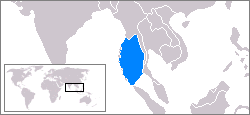
The Andaman Sea is a marginal sea of northeastern Indian Ocean bounded by the coastlines of Myanmar and Thailand along the Gulf of Martaban and west side of the Malay Peninsula, and separated from the Bay of Bengal to its west by the Andaman Islands and the Nicobar Islands. Its southernmost end is defined by Breueh Island, an island just north of Sumatra, and communicates with the Malacca Strait.
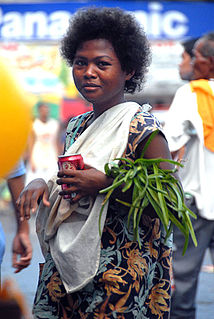
The Negrito are several diverse ethnic groups who inhabit isolated parts of Southeast Asia and the Andaman Islands. Their current populations include: the Andamanese peoples of the Andaman Islands, the Semang peoples of Peninsular Malaysia, the Maniq people of Southern Thailand, as well as the Aeta of Luzon Island, Ati and Tumandok of Panay Island, Agta of Sierra Madre and Mamanwa of Mindanao Island and about 30 other officially recognized ethnic groups in the Philippines.

The Andamanese languages are a pair of language families spoken by the Andamanese peoples of the Andaman Islands in the Indian Ocean. The two language families are Great Andamanese and Ongan, while the Sentinelese language is spoken by an uncontacted people and therefore at present unclassifiable.
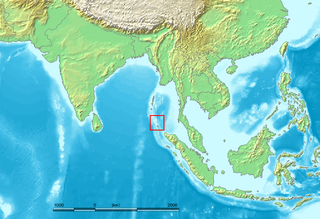
The Nicobar Islands are an archipelagic island chain in the eastern Indian Ocean. They are located in Southeast Asia, 150 km north of Aceh on Sumatra, and separated from Thailand to the east by the Andaman Sea. Located 1,300 km southeast of the Indian subcontinent, across the Bay of Bengal, they form part of the Union Territory of Andaman and Nicobar Islands, India.
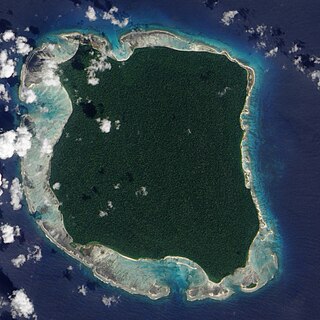
North Sentinel Island is one of the Andaman Islands, an archipelago in the Bay of Bengal which also includes South Sentinel Island. It is home to the Sentinelese, an indigenous people in voluntary isolation who have defended, often by force, their protected isolation from the outside world.

The Sentinelese, also known as the Sentineli and the North Sentinel Islanders, are an indigenous people who inhabit North Sentinel Island in the Bay of Bengal in India. Designated a Particularly Vulnerable Tribal Group and a Scheduled Tribe, they belong to the broader class of Andamanese peoples.

The Andamanese are the various indigenous peoples of the Andaman Islands, part of India's Andaman and Nicobar Islands union territory in the southeastern part of the Bay of Bengal in Southeast Asia. The Andamanese peoples are among the various groups considered Negrito, owing to their dark skin and diminutive stature. All Andamanese traditionally lived a hunter-gatherer lifestyle, and appear to have lived in substantial isolation for thousands of years. It is suggested that the Andamanese settled in the Andaman Islands around the latest glacial maximum, around 26,000 years ago.

Port Blair is the capital city of the Andaman and Nicobar Islands, a union territory of India in the Bay of Bengal. It is also the local administrative sub-division (tehsil) of the islands, the headquarters for the district of South Andaman and is the territory's only notified town.

Great Nicobar is the southernmost and largest of the Nicobar Islands of India, north of Sumatra.

South Sentinel Island is one of the Andaman Islands in the Bay of Bengal. It is 1.6 km (0.99 mi) long northeast to southwest and up to 1 km (0.62 mi) wide. At only 1.61 km2 (0.62 sq mi), it is much smaller than its counterpart North Sentinel Island and is currently uninhabited. The island belongs to the Port Blair tehsil in the South Andaman administrative district, part of the Indian union territory of Andaman and Nicobar Islands, neighbouring North Sentinel Island.
Mount Thuillier is the highest point in the Nicobar Islands, located in the Indian Ocean and bordering on the Andaman Sea. The mountain is located on the island of Great Nicobar, measuring 642 m (2,106 ft) above sea level. Its geology features intrusive igneous rock formations, such as gabbro, combined with metamorphic minerals such as serpentine.

Drypetes is a plant genus of the family Putranjivaceae, in the order Malpighiales.

The Onge are an indigenous people of Little Andaman, one of the Andaman Islands in India. Traditionally hunter-gatherers, they are one of the Andamanese peoples and are designated as a Scheduled Tribe.

The Bale language, Akar-Bale, is an extinct Southern Great Andamanese language once spoken in the Andaman Islands in Ritchie's Archipelago, Havelock Island, and Neill Island.
The Jarawas are an indigenous people of the Andaman Islands in India. They live in parts of South Andaman and Middle Andaman Islands, and their present numbers are estimated at between 250–400 individuals. They have largely shunned interaction with outsiders, and many particulars of their society, culture and traditions are poorly understood. Since the 1990s, contacts between Jarawa groups and outsiders grew increasingly frequent. By the 2000s, some Jarawas had become regular visitors at settlements, where they trade, interact with tourists, get medical aid, and even send their children to school.

The Andaman and Nicobar Command (ANC) is the first and only tri-service theater command of the Indian Armed Forces, based at Port Blair in the Andaman and Nicobar Islands, a Union Territory of India. It was created in 2001 to safeguard India's strategic interests in Southeast Asia and the Strait of Malacca by increasing rapid deployment of military assets in the region. It provides logistical and administrative support to naval ships which are sent on deployment to East Asia and the Pacific Ocean.
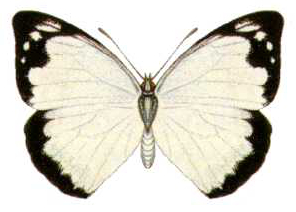
Appias paulina, the common albatross, Christmas Island white or Ceylon lesser albatross, is a butterfly of the family Pieridae. It is found from India to Samoa, including Indonesia, Japan, Malaysia, New Caledonia, Sri Lanka, Thailand and Australia.
National Highway 4, or NH 4, is the major highway in the Indian state of Andaman and Nicobar Islands. It is 230.7 km in length. This road running from the capital city of Port Blair to Diglipur connecting all major towns of Ferrargunj, Baratang, Kadamtala, Rangat, Billy Ground, Nimbudera, Mayabunder and Diglipur. This highway is known as the Andaman Trunk Road.













